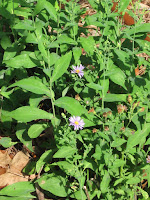I like blue (and blue-ish) flowers best of all, so I have lots. This is false hyssop, Agastache foeniculum ‘Blue Fortune.’ Bees and butterflies love it, deer disdain it because of its anise-scented foliage. It’s not reliably perennial for me, but I don’t care because Christine grows some every year.
 Our cat
Fred thinks catmint—Nepeta x faassenii ‘Walkers
Low’—might actually be catnip. He’s wrong, of course, although it’s aromatic
enough that deer don’t bother it. While “Walkers Low” refers not to the height
of the plant but to an English garden, Fred keeps ours well below the 30 inches
gardeners without 18-pound pets can expect.
Our cat
Fred thinks catmint—Nepeta x faassenii ‘Walkers
Low’—might actually be catnip. He’s wrong, of course, although it’s aromatic
enough that deer don’t bother it. While “Walkers Low” refers not to the height
of the plant but to an English garden, Fred keeps ours well below the 30 inches
gardeners without 18-pound pets can expect.
The
passionflowers I observe for the National PhenologyNetwork’s Nature’s Notebook bloomed early this year due to the mild
winter. Which is nice.
This
blue-themed pot contains annual Phlox
intensia ‘Blueberry’ and a selection of summer snapdragons, Angelonia angustifolia-Serena series.
My poor
aster. Not only is it stuck with a nasty botanical name—Symphyotrichum laevis—but deer uncharacteristically grazed it
nearly down to the ground earlier in the season in a fit of pique over our
fencing of the tomatoes. So now it’s blooming. Be interesting to see what
happens this fall.
 My next
favorite flower colors are the pinks, purples and magentas, so I have lots of
those, too. Here is a clump of perennial petunias, Petunia integrifolia integrifolia. I have no idea why the specific
epithet is repeated. One year I planted these free-flowering magenta beauties in a raised bed with
chartreuse sweet-potato vine (Ipomoea
batatas ‘Margarita’): the effect was stunning. Also not reliably perennial,
it survived this year’s mild winter handily, never even dying back all the way.
My next
favorite flower colors are the pinks, purples and magentas, so I have lots of
those, too. Here is a clump of perennial petunias, Petunia integrifolia integrifolia. I have no idea why the specific
epithet is repeated. One year I planted these free-flowering magenta beauties in a raised bed with
chartreuse sweet-potato vine (Ipomoea
batatas ‘Margarita’): the effect was stunning. Also not reliably perennial,
it survived this year’s mild winter handily, never even dying back all the way.
One of the mildew-resistant garden phloxes, Phlox paniculata ‘Bright Eyes,’ keeps large pink panicles coming for most of the season. ‘Laura’ is another cultivar I like, with blooms more on the purple side of pink, but she’s not blooming yet.
This Liatris spicata, saddled with the dopey
common name “blazing star,” is a specimen of the straight species, lankier and
earlier than the stocky cultivar ‘Kobold’ that grows on the other side of the
garden.

My specimen of evergreen Serissa foetida started life as a tiny bonsai I rescued from the Philadelphia Flower Show in 2005. It certainly wouldn’t fit back into the two-inch-wide pot it came in anymore.
This is rock rose, Pavonia lasiopetala. A shrubby little thing, it produces its cheerful cerise cup-shaped flowers steadily—if not prolifically—all summer.
Another trouble-free sub-shrub that enjoyed the warm winter was my swamp mallow (Kosteletzkya virginica—see “Field Notes for the Weary” post of September 28, 2011). Its first bloom appeared ten days ago, weeks ahead of schedule.
Christine
spoiled plain ol’ squatty Gomphrena
globosa by introducing me to G.
haageana ‘Fireworks.’ The cerise flowers with yellow “sparks” certainly
live up to their name, and keep coming from mid-spring into October.

And how can any one have a garden without classic Zinnia elegans? This cultivar is called ‘Cut and Come Again’ for good reason.
I depend
on the black-eyed Susans for yellows in my gardens. Perennial Rudbeckia fulgida subspecies and
cultivars provide the color in fall, but wonderful annual (but freely seeding) R. hirta ‘Indian Summer’ carries the
torch until then.
The sunflowers are blooming! The sunflowers are blooming! These are Helianthus annuus ‘Van Gogh.’

When I lived up North, I loved nasturtiums. Over a season they’d grow into huge frothy mounds of neatly round foliage dotted with orange, yellow or red flowers. Not so in North Carolina, where the heat takes a toll. Regardless, I plant some every spring and enjoy them until they inevitably crash.
I don’t have a lot of summertime whites in my garden, so for now, I’m grateful for the dainty blooms of my potato crop, Solanum tuberosum.
So
that’s what’s providing color out in my yard today. And that’s all I have to
say, until next time.
Thanks
for dropping by.
Kathy












No comments:
Post a Comment